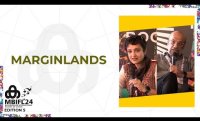Arati Kumar-Rao: Marginlands
For this 2024 Mathrubhumi International Festival of Letters event, Arati Kumar-Rao talks about how her book, Marginlands: A Journey Into India’s Vanishing Landscapes (Milkweed Editions, 2025), is not about a specific place, but can be somewhere at “the edge of our psyche” in a conversation with Prem Panicker. Rao’s book is featured in Page One in the March/April issue of Poets & Writers Magazine.





